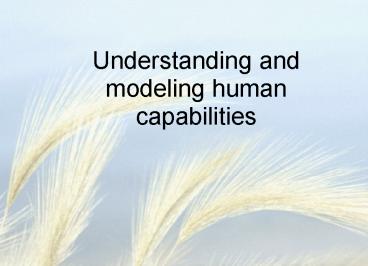Understanding and modeling human capabilities - PowerPoint PPT Presentation
1 / 35
Title:
Understanding and modeling human capabilities
Description:
Idea: If we can build a model of how a user works, then we ... Dagger. Door. Dart. Dress. Dancing. Duck. 9 words that begin with 'd' 9 words that begin with 'f' ... – PowerPoint PPT presentation
Number of Views:74
Avg rating:3.0/5.0
Title: Understanding and modeling human capabilities
1
Understanding and modeling human capabilities
2
Agenda
- Questions
- Overview of Modeling
- Humans as information processors
- DFAB sensory discussion
- CMN perceptual / motor / cognitive
- Fitts Law for modeling movement
3
Basic human capabilities
- Humans evolve much more slowly than technology
- There are limits to human capabilities
4
What is a model?
- Abstracted
- Often simplified
- Representation of real world concept (eg. People,
objects, processes) - Idea If we can build a model of how a user
works, then we can predict how s/he will interact
with the interface - Predictive model ? predictive evaluation
5
Overview of Modeling
- What are the questions
- How to gather information
- How to model that information
6
What can we model
- Sensory / Motor processes
- Cognitive processes
- Tasks
- Contexts
7
Two types of user modeling
- Stimulus-Response
- Hicks law
- Fitts law
- Cognitive human as interperter/predictor
based on Model Human Processor (MHP) - Key-stroke Level Model
- Low-level, simple
- GOMS (and similar) Models
- Higher-level (Goals, Operations, Methods,
Selections
8
Humans as I/O machines
- Senses
- vision
- hearing
- touch
- smell/taste
- Feed sensory memory, then processing
- What are the design implications?
9
Design implications
- Vision
- e.g., acuity and color, optical illusions
- Hearing
- e.g., frequency response, filtering
- Touch/motor movement
- e.g. tactile sensitivity, movement time
10
Memory
- 3 kinds
- distinguished by
- main code type
- storage capacity
- decay time of an item
11
Sensory/Perceptual memory an experiment
12
Sensory / Perceptual Memory
- physically encoded
- impacted by physical characteristics of signal
- low capacity
- rapid decay (msec)
13
Working/Short-term memory an experiment
- C R T I B M C B S N H L
14
Was was that?
15
Working/Short-term memory
- How about now?
- CRT IBM CBS NHL
16
Short-Term or Working Memory
- symbolic, nonphysical acoustic or visual coding
- 7 plus/minus 2 chunks
- decay 5-226 sec
17
What is a chunk
- a meaningful grouping of information
- 4 7 9 3 6 1 9 0 4 9
- vs
- 404 894 7243
- User and task dependent
18
Another experiment in working memory
- Two volunteers
19
9 words that begin with d
- Doughnut
- Deer
- Dog
- Dagger
- Door
- Dart
- Dress
- Dancing
- Duck
20
9 words that begin with f
21
Long term memory
- semantic information
- episodic information
- capacity (limitless?)
- no decay?
- Catch Retrieval depends on associations
22
Principles for retrieval
- How information is perceived, understood and
encoded determines likelihood of retrieval
23
Variation in humans
- Human capabilities and limitations can be
generalized only to an extent - Variation between people (eg. age, gender,
intelligence, physical capability) - Variation within people (stress, fatigue)
24
Hicks Law
- Decision time to choose among n equally likely
alternatives - T Ic log2(n1)
- Ic 150 msec
- What might this be good for?
25
One possible use
- Menu selection
- Which will be faster as way to choose from 64
choices? Go figure - Single menu of 64 items
- Two-level menu of 8 choices at each level
- Two-level menu of 4 and then 16 choices
- Two-level menu of 16 and then 4 choices
- Three-level menu of 4 choices at each level
- Binary menu with 6 levels
26
Fitts Law
- Models movement times for selection (reaching)
tasks in one dimension - Basic idea Movement time (MT) is proportional to
Index of difficulty (ID) of a selection task - MT Increases as distance to target increases
- MT Decreases as size of target increases
27
Original Experiment
d
w
- 1-D
28
Index of difficulty (ID)
- Measure difficulty of selection task
- ID log2(2d/w)
- bits
- d distance between targets
- w target width
29
Movement time (MT)
MT
- MT a b ID
Difficulty
30
How MT is determined
- Empirical measurement establishes constants a and
b - Different for different devices and different
ways the same device is used.
31
Applications
- When does it apply? When does it not?
- How used in interface design?
32
Extending to 2D
- What is w?
33
Possible ws for 2D
- smaller-of
- W (width of target along the approach vector)
34
Project time?
35
Upcoming
- Cognitive models
- CMN chapter (online), DFAB 12.2, 12.5 (skip 12.3,
12.4) - Part 1 due 6/02































